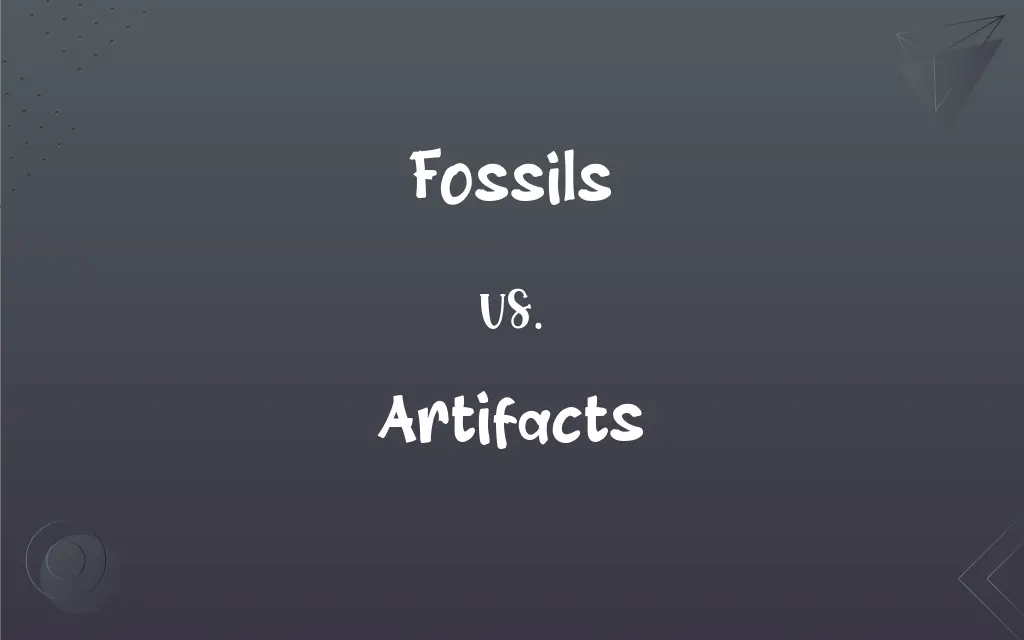Fossils vs. Artifacts: What's the Difference?
Edited by Janet White || By Harlon Moss || Updated on October 25, 2023
Fossils are remains of ancient organisms, while artifacts are man-made objects from past cultures.

Key Differences
Fossils are tangible evidence of life from previous geological eras, capturing the essence of ancient organisms in stone. These remains provide crucial insight into the evolution and diversification of life on Earth. Artifacts, on the other hand, are creations of human hands, relics of past civilizations, and tell tales of our ancestors' way of life, technology, and artistic prowess.
The formation of fossils involves natural processes where organic materials, such as bones or plants, undergo mineralization, preserving them for millions of years. Artifacts, however, come into being due to human ingenuity. Whether it's a stone tool, a piece of pottery, or an intricately designed jewelry item, artifacts illustrate the progression of human culture and technological innovation.
It's fascinating how fossils can paint a vivid picture of extinct creatures, giving glimpses into prehistoric ecosystems and their inhabitants. From dinosaurs to ancient plants, fossils chronicle a vast history of life. Artifacts, however, chart human history, spotlighting cultural practices, societal norms, and even day-to-day life from epochs gone by.
While both fossils and artifacts serve as windows to the past, their study falls under different scientific domains. Paleontologists primarily study fossils, dissecting Earth's biological history, while archaeologists delve into artifacts, unraveling the tapestry of human civilizations and their evolutions.
The sheer age of fossils can span hundreds of millions of years, capturing the vestiges of life from various geologic periods. Artifacts, in comparison, span the breadth of human history, from ancient civilizations like the Sumerians and Egyptians to more recent historical events and cultures.
ADVERTISEMENT
Comparison Chart
Origin
Remains of ancient organisms
Man-made objects
Formation
Natural processes like mineralization
Human creation
Study
Primarily by paleontologists
Primarily by archaeologists
Timespan
Can be hundreds of millions of years old
Span the course of human history
Purpose
Provide insight into ancient life and ecosystems
Shed light on human culture, tech, and practices
ADVERTISEMENT
Fossils and Artifacts Definitions
Fossils
Fossils can be formed from bones, plants, or imprints.
The leaf fossils showed intricate vein patterns.
Artifacts
Artifacts represent cultural or historical significance.
These artifacts offer insight into medieval life.
Fossils
Fossils are preserved remains of ancient life.
Scientists found fossils of a new dinosaur species.
Artifacts
Artifacts provide insight into technological advancement.
The artifacts showed the community's metallurgical skills.
Fossils
Fossils can be microscopic to massive in size.
The fossils of pollen grains helped scientists deduce the ancient climate.
Artifacts
Artifacts are objects created by human beings.
The museum displayed artifacts from ancient Egypt.
Fossils
Fossils help in understanding evolutionary history.
Fossils of early fish revealed their transition to land.
Artifacts
Artifacts can be tools, art, or everyday items.
Stone tools are some of the earliest known artifacts.
Fossils
Fossils are often found in sedimentary rock layers.
The canyon was a treasure trove of marine fossils.
Artifacts
Artifacts can be made from various materials like stone, metal, or clay.
The bronze artifacts were remarkably well-preserved.
Fossils
A remnant or trace of an organism of a past geologic age, such as a skeleton or leaf imprint, embedded and preserved in the earth's crust.
Artifacts
An object produced or shaped by human craft, especially a tool, weapon, or ornament of archaeological or historical interest.
FAQs
Are fossils and artifacts the same thing?
No, fossils are ancient life remains, while artifacts are man-made objects.
Can footprints become fossils?
Yes, footprints can fossilize and are known as trace fossils.
How are fossils discovered?
Many are found during excavations, construction, or by fossil hunters.
What materials can artifacts be made from?
Artifacts can be made from stone, metal, clay, bone, and other materials.
Can plants become fossils?
Yes, plants can and have become fossils, revealing ancient flora.
What role do artifacts play in museums?
Artifacts help convey cultural, historical, and technological narratives.
Can artifacts offer clues to unsolved historical mysteries?
Yes, artifacts can provide crucial insights into unknown historical events.
How are fossils formed?
Fossils form when organic remains undergo mineralization over millions of years.
Are all old objects considered artifacts?
Only objects made or modified by humans are considered artifacts.
Can fossils be dated?
Yes, techniques like radiometric dating help determine a fossil's age.
Why are some fossils found in odd places, like marine animals on mountains?
Tectonic forces can lift ancient sea floors, turning them into mountains.
Are artifacts only ancient objects?
No, artifacts can be from any period, including recent history.
Are there fake fossils and artifacts?
Yes, fakes exist and require expertise to differentiate from genuine specimens.
What is the oldest artifact ever found?
Stone tools, over 3 million years old, are among the oldest known artifacts.
Are there places where fossils are more abundant?
Fossils are often abundant in sedimentary rock formations.
What happens to an organism's soft parts during fossilization?
Soft parts often decay, but in rare conditions, they can fossilize.
How are artifacts preserved?
Artifacts can be preserved by methods like desiccation, freezing, or in oxygen-poor environments.
What do fossils reveal about Earth's history?
Fossils showcase ancient life, ecosystems, and evolutionary trends.
How are artifacts authenticated?
Through expert examination, scientific testing, and provenance research.
Can an artifact be both a tool and an artwork?
Absolutely, many artifacts, like decorated pottery, serve multiple purposes.
About Author
Written by
Harlon MossHarlon is a seasoned quality moderator and accomplished content writer for Difference Wiki. An alumnus of the prestigious University of California, he earned his degree in Computer Science. Leveraging his academic background, Harlon brings a meticulous and informed perspective to his work, ensuring content accuracy and excellence.
Edited by
Janet WhiteJanet White has been an esteemed writer and blogger for Difference Wiki. Holding a Master's degree in Science and Medical Journalism from the prestigious Boston University, she has consistently demonstrated her expertise and passion for her field. When she's not immersed in her work, Janet relishes her time exercising, delving into a good book, and cherishing moments with friends and family.































































